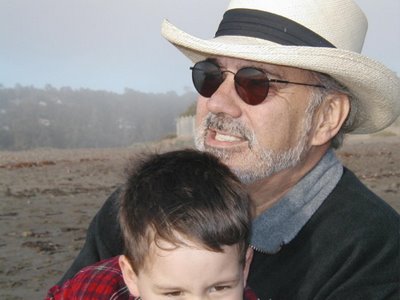
When is your life no longer colored by the way it ends? With a death by suicide, I don't know if it ever is. Three years ago, my uncle and my godfather, Ken Gotschall Jr. ended his life in a wooded park in Lodi. For months we pondered why and tried to find someone to blame, like his ex-wife. It was comforting, for some family members, to imagine that he was murdered. Living in the aftermath of suicide is like that. Our family has gone through this twice.
I want to remember my uncle without wondering about this exit plan simmering in the back of his mind - how long did he consider it an option? I want to remember long summer weeks spent at his house on Central Ave. in Manteca. I want to remember the pleasure he took in his garden, the eggs he received from his chickens, how he could make a mean BBQ. I want to remember the way he said my name. I want to remember his voice, his smell. Not that horrible week when we learned he left us and how.
I was heartened to learn that progress has been made in erecting a suicide barrier for the Golden Gate Bridge (SF Chronicle)
Here's a link to an amazing article about suicide in general and the "allure" of the Golden Gate Bridge for the suicidal, from The New Yorker.
Here are two excerpts that I think are especially important.
A familiar argument against a barrier is that thwarted jumpers will simply go elsewhere. In 1953, a bridge supervisor named Mervin Lewis rejected an early proposal for a barrier by saying it was preferable that suicides jump into the Bay than dive off a building “and maybe kill somebody else.” (It’s a public-safety issue.) Although this belief makes intuitive sense, it is demonstrably untrue. Dr. Seiden’s study, “Where Are They Now?,” published in 1978, followed up on five hundred and fifteen people who were prevented from attempting suicide at the bridge between 1937 and 1971. After, on average, more than twenty-six years, ninety-four per cent of the would-be suicides were either still alive or had died of natural causes. “The findings confirm previous observations that suicidal behavior is crisis-oriented and acute in nature,” Seiden concluded; if you can get a suicidal person through his crisis—Seiden put the high-risk period at ninety days—chances are extremely good that he won’t kill himself later.I regret that we could not get my uncle through his crisis period. He'd had an attempt less than a month before his "successful" completion. I had just completed a video for teenagers about depression and suicide and knew he was in danger. My conversations with him were futile. He did not confide in me about the depth of his pain.
Here is another powerful excerpt from The New Yorker piece. This quote made it into the zeitgeist, and colored various episodic TV shows for months afterward - it actually was quoted in one show (can't remember which - ER?)
Survivors often regret their decision in midair, if not before. Ken Baldwin and Kevin Hines both say they hurdled over the railing, afraid that if they stood on the chord they might lose their courage. Baldwin was twenty-eight and severely depressed on the August day in 1985 when he told his wife not to expect him home till late. “I wanted to disappear,” he said. “So the Golden Gate was the spot. I’d heard that the water just sweeps you under.” On the bridge, Baldwin counted to ten and stayed frozen. He counted to ten again, then vaulted over. “I still see my hands coming off the railing,” he said. As he crossed the chord in flight, Baldwin recalls, “I instantly realized that everything in my life that I’d thought was unfixable was totally fixable—except for having just jumped.”
Kenny jumped. We're still here.
No comments:
Post a Comment